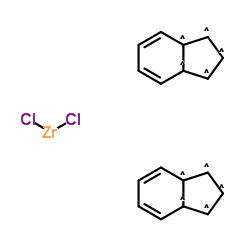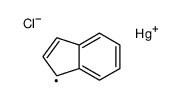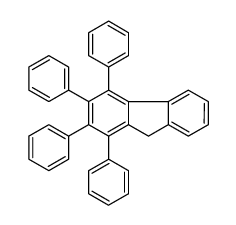dichlorobis(indenyl)zirconium(iv)

dichlorobis(indenyl)zirconium(iv) structure
|
Common Name | dichlorobis(indenyl)zirconium(iv) | ||
|---|---|---|---|---|
| CAS Number | 12148-49-1 | Molecular Weight | 392.434 | |
| Density | N/A | Boiling Point | N/A | |
| Molecular Formula | C18H14Cl2Zr | Melting Point | 239-243ºC(lit.) | |
| MSDS | N/A | Flash Point | N/A | |
| Name | dichlorobis(indenyl)zirconium(iv) |
|---|---|
| Synonym | More Synonyms |
| Melting Point | 239-243ºC(lit.) |
|---|---|
| Molecular Formula | C18H14Cl2Zr |
| Molecular Weight | 392.434 |
| Exact Mass | 389.951965 |
| LogP | 5.15480 |
Synonym: Section 2 - COMPOSITION, INFORMATION ON INGREDIENTS
Risk Phrases: 15 34 Section 3 - HAZARDS IDENTIFICATION EMERGENCY OVERVIEW
Contact with water liberates extremely flammable gases. Causes burns.Moisture sensitive.Air sensitive. Potential Health Effects Eye: Causes eye burns. Skin: Causes skin burns. Ingestion: Causes gastrointestinal tract burns. Inhalation: Causes chemical burns to the respiratory tract. Chronic: Not available. Section 4 - FIRST AID MEASURES Eyes: Immediately flush eyes with plenty of water for at least 15 minutes, occasionally lifting the upper and lower eyelids. Get medical aid immediately. Skin: Get medical aid immediately. Immediately flush skin with plenty of water for at least 15 minutes while removing contaminated clothing and shoes. Ingestion: Get medical aid immediately. Do NOT induce vomiting. If conscious and alert, rinse mouth and drink 2-4 cupfuls of milk or water. Inhalation: Get medical aid immediately. Remove from exposure and move to fresh air immediately. If not breathing, give artificial respiration. If breathing is difficult, give oxygen. Notes to Physician: Treat symptomatically and supportively. Section 5 - FIRE FIGHTING MEASURES General Information: As in any fire, wear a self-contained breathing apparatus in pressure-demand, MSHA/NIOSH (approved or equivalent), and full protective gear. Water hydrolyzes material liberating acidic gas which in contact with metal surfaces can generate flammable and/or explosive hydrogen gas. Extinguishing Media: DO NOT USE WATER! In case of fire, use carbon dioxide, dry chemical powder or appropriate foam. Section 6 - ACCIDENTAL RELEASE MEASURES General Information: Use proper personal protective equipment as indicated in Section 8. Spills/Leaks: Vacuum or sweep up material and place into a suitable disposal container. Avoid generating dusty conditions. Isolate area and deny entry. Section 7 - HANDLING and STORAGE Handling: Do not breathe dust, vapor, mist, or gas. Do not get in eyes, on skin, or on clothing. Use and store under nitrogen. Use only in a chemical fume hood. Storage: Store in a cool, dry place. Store in a tightly closed container. Keep away from water. Corrosives area. Store under nitrogen. Section 8 - EXPOSURE CONTROLS, PERSONAL PROTECTION Engineering Controls: Facilities storing or utilizing this material should be equipped with an eyewash facility and a safety shower. Use adequate ventilation to keep airborne concentrations low. Exposure Limits CAS# 12148-49-1: Personal Protective Equipment Eyes: Not available. Skin: Wear appropriate protective gloves to prevent skin exposure. Clothing: Wear appropriate protective clothing to prevent skin exposure. Respirators: Follow the OSHA respirator regulations found in 29 CFR 1910.134 or European Standard EN 149. Use a NIOSH/MSHA or European Standard EN 149 approved respirator if exposure limits are exceeded or if irritation or other symptoms are experienced. Section 9 - PHYSICAL AND CHEMICAL PROPERTIES Physical State: Solid Color: Not available. Odor: Not available. pH: Not available. Vapor Pressure: Not available. Viscosity: Not available. Boiling Point: Not available. Freezing/Melting Point: 239-243 deg C Autoignition Temperature: Not available. Flash Point: Not available. Explosion Limits, lower: Not available. Explosion Limits, upper: Not available. Decomposition Temperature: Solubility in water: Specific Gravity/Density: Molecular Formula: C18H14Cl2Zr Molecular Weight: 392.43 Section 10 - STABILITY AND REACTIVITY Chemical Stability: Not available. Conditions to Avoid: Incompatible materials, exposure to air, exposure to moist air or water. Incompatibilities with Other Materials: Strong oxidizing agents, acids, bases, chemically active metals. Hazardous Decomposition Products: Hydrogen chloride, carbon monoxide, carbon dioxide. Hazardous Polymerization: Has not been reported Section 11 - TOXICOLOGICAL INFORMATION RTECS#: CAS# 12148-49-1 unlisted. LD50/LC50: Not available. Carcinogenicity: Dichlorobis(indenyl)zirconium(IV) - Not listed by ACGIH, IARC, or NTP. Section 12 - ECOLOGICAL INFORMATION Section 13 - DISPOSAL CONSIDERATIONS Dispose of in a manner consistent with federal, state, and local regulations. Section 14 - TRANSPORT INFORMATION IATA Shipping Name: Corrosive solid, acidic, organic, n.o.s.* Hazard Class: 8 UN Number: 3261 Packing Group: III IMO Shipping Name: Corrosive solid, acidic, organic, n.o.s. Hazard Class: 8 UN Number: 3261 Packing Group: III RID/ADR No information available. Section 15 - REGULATORY INFORMATION European/International Regulations European Labeling in Accordance with EC Directives Hazard Symbols: C Risk Phrases: R 15 Contact with water liberates extremely flammable gases. R 34 Causes burns. Safety Phrases: S 7/8 Keep container tightly closed and dry. S 26 In case of contact with eyes, rinse immediately with plenty of water and seek medical advice. S 36/37/39 Wear suitable protective clothing, gloves and eye/face protection. S 45 In case of accident or if you feel unwell, seek medical advice immediately (show the label where possible). WGK (Water Danger/Protection) CAS# 12148-49-1: No information available. Canada CAS# 12148-49-1 is listed on Canada's NDSL List. CAS# 12148-49-1 is not listed on Canada's Ingredient Disclosure List. US FEDERAL TSCA CAS# 12148-49-1 is listed on the TSCA inventory. SECTION 16 - ADDITIONAL INFORMATION N/A |
| Hazard Codes | C: Corrosive; |
|---|---|
| Risk Phrases | R15 |
| Safety Phrases | 26-27-36/37/39-45 |
| RIDADR | UN 3261 8/PG 3 |
| HS Code | 2903999090 |
|
~33% 
dichlorobis(ind... CAS#:12148-49-1 |
| Literature: Piccolrovazzi, Nicoletta; Pino, Piero; Consiglio, Gamgattista; Sironi, Angelo; Moret Massimo Organometallics, 1990 , vol. 9, p. 3098 - 3105 |
|
~50% 
dichlorobis(ind... CAS#:12148-49-1 |
| Literature: Lapczuk-Krygier, Agnieszka; Baranowska, Katarzyna; Ponikiewski, Lukasz; Matern, Eberhard; Pikies, Jerzy Inorganica Chimica Acta, 2012 , vol. 387, p. 361 - 365 |
|
~95%
Detail
|
| Literature: Balboni, Davide; Camurati, Isabella; Ingurgio, Antonio Cascio; Guidotti, Simona; Focante, Francesca; Resconi, Luigi Journal of Organometallic Chemistry, 2003 , vol. 683, # 1 p. 2 - 10 |
|
~90%
Detail
|
| Literature: Balboni, Davide; Camurati, Isabella; Ingurgio, Antonio Cascio; Guidotti, Simona; Focante, Francesca; Resconi, Luigi Journal of Organometallic Chemistry, 2003 , vol. 683, # 1 p. 2 - 10 |
|
~% 
dichlorobis(ind... CAS#:12148-49-1 |
| Literature: Organometallics, , vol. 21, p. 920 - 923 |
|
~% 
dichlorobis(ind... CAS#:12148-49-1 |
| Literature: Journal of Organometallic Chemistry, , vol. 683, # 1 p. 2 - 10 |
|
~% 
dichlorobis(ind... CAS#:12148-49-1 |
| Literature: Synthesis and Reactivity in Inorganic and Metal-Organic Chemistry, , vol. 13, p. 1059 - 1066 |
| Precursor 8 | |
|---|---|
| DownStream 2 | |
| HS Code | 2903999090 |
|---|---|
| Summary | 2903999090 halogenated derivatives of aromatic hydrocarbons VAT:17.0% Tax rebate rate:9.0% Supervision conditions:none MFN tariff:5.5% General tariff:30.0% |
| 2,3-Dihydro-1H-indene-1,2,3,3a,7a-pentayl - dichlorozirconium (2:1) |









 CAS#:23022-37-9
CAS#:23022-37-9 CAS#:64465-03-8
CAS#:64465-03-8